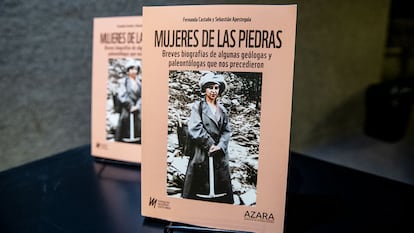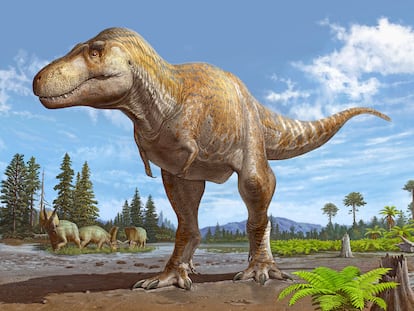The forgotten women scientists who studied dinosaurs and rocks
A book recovers the biographies of over 170 female paleontologists and geologists from around the world, from the beginning of these disciplines through today

A woman discovered the first dinosaur ever studied by scientists. In 1822, Mary Anne Woodhouse’s trained eye was able to discern some huge teeth on the side of a road in southern England. Those teeth turned out to be from an iguanodon, a three-ton, 120-million-year-old herbivorous reptile. It was the first dinosaur to be studied by science, one of the three that gave rise to the term for the first time in history; it was also the first of many cases in which a woman’s contribution was forgotten. That specimen was registered in the name of Gideon Mantell, Woodhouse’s husband and a physician who was an amateur paleontologist; until the 20th century, only men had the right to record their scientific discoveries.
Woodhouse’s story is similar to those of the 170 other pioneering women discussed in the book Mujeres de las piedras (Women of stone), written by paleontology student Fernanda Castaño and researcher Sebastián Apesteguía; the tome was recently published by Vázquez Mazzini Editorial and the Azara Foundation. At over 360 pages long, the material offers brief biographies, from pioneering amateurs to current professionals, during different historical periods across five continents.
This compilation of these female scientists’ life stories points to some clear conclusions: European women were a worldwide inspiration, especially British women. They got their first opportunity thanks to their class privileges and generous partners (fathers or husbands), who availed themselves of their patriarchal advantages — to different degrees, depending on the case — to pave the way for women scientists. And the glass ceiling that delimited their expertise has not yet been broken.
Author Fernanda Castaño was fascinated by British scientist Mary Horner: “Her father, a rather important geologist with the Geological Society of London, instilled a scientific vocation in his two daughters. Mary’s sister devoted herself to botany. She not only made illustrations of what she saw in the field but tried to study it. I think that’s a fantastic example,” she says. Those parents did not give their daughters the customary education of wives and hostesses but seemed to want a more stimulating and exploratory life for them and educated them in science and languages.

Indeed, some relationships were so progressive that they seem out of context. Co-author Apesteguía offers the example of Hawaiian Annie Montague Alexander’s relationship with her father in the 19th century. “It made her super independent and her habits were very masculine for the time. She shot rifles, hunted, climbed with him. In fact, her father died on an expedition in Africa, in Victoria Falls; [he was] crushed by a rock, in front of her.” Castaño adds that “she was a lesbian, she had many female companions in her life, and he never had a problem accepting it; he supported her. He was a very interesting character.”
Mary Anning is one of the most famous female scientists, and there are books and movies about her life. Her father was a modest carpenter and fossil hobbyist who trained her and her brother in fossil collecting. Because of his influence, she was able to find the first remains of several specimens that later became popular, such as those of the Ichthyosaurus, the first complete Plesiosaurus, the first pterosaur found outside Germany, and numerous ammonites, a kind of tentacled snail from 400 million years ago.
Despite these promising beginnings, women remained trapped in small subjects, like plants, air or water. That is, they were active in the disciplinary gaps that men were not interested in pursuing. “There aren’t many women who went into studying dinosaurs. In general, they were micropaleontologists or paleobotanists. They didn’t usually go prospecting because they weren’t allowed to. That was a male thing, so they were left with the subjects that men did not work on,” Castaño explains. “Nowadays, in the case of vertebrates, there is even a tendency for many female paleontologists to work on marine mammals or reptiles. So, there are not that many women working on dinosaurs because men worked on the large saurians.”
The discovery of these women scientists’ careers touched Apesteguía personally. “I had not realized that there were no women in certain subjects until, having already written the book, I started looking and saw that one of the great pioneers in Argentina was my director Zulma Brandoni de Gasparini.” He recognizes that “there are still few women in paleontology’s star subjects.” While popularity and fame are not the motivation of those who dedicate themselves to science, women scientists’ low visibility in the field affects other vocations and their social valuation.
That bond of solidarity between fathers and daughters that drove the first female paleontologists and geologists is somehow reintroduced in the partnership between the authors of Women of Stone. A well-versed researcher, Apesteguía discovered Castaño’s blog and suggested that she write the book. “I was really amazed by what she posted, I discovered stories thanks to her and she inspired me to contact her and discuss the idea,” says the paleontologist. Castaño likens it to a soccer achievement. “Imagine. I’m studying paleontology and Sebastián Apesteguía contacts me to write the book. It was as if I had been promoted to River Plate’s first team.”
Although the book is very comprehensive, the authors continue to discover relevant biographies of female scientists around the world, so they are already thinking about a second volume.
Sign up for our weekly newsletter to get more English-language news coverage from EL PAÍS USA Edition
Tu suscripción se está usando en otro dispositivo
¿Quieres añadir otro usuario a tu suscripción?
Si continúas leyendo en este dispositivo, no se podrá leer en el otro.
FlechaTu suscripción se está usando en otro dispositivo y solo puedes acceder a EL PAÍS desde un dispositivo a la vez.
Si quieres compartir tu cuenta, cambia tu suscripción a la modalidad Premium, así podrás añadir otro usuario. Cada uno accederá con su propia cuenta de email, lo que os permitirá personalizar vuestra experiencia en EL PAÍS.
¿Tienes una suscripción de empresa? Accede aquí para contratar más cuentas.
En el caso de no saber quién está usando tu cuenta, te recomendamos cambiar tu contraseña aquí.
Si decides continuar compartiendo tu cuenta, este mensaje se mostrará en tu dispositivo y en el de la otra persona que está usando tu cuenta de forma indefinida, afectando a tu experiencia de lectura. Puedes consultar aquí los términos y condiciones de la suscripción digital.
More information
Últimas noticias
Maduro pleads not guilty before the federal court in New York: ‘I am still the president of Venezuela’
A new test can detect Alzheimer’s from a finger prick
UN team enters Sudanese city of El Fasher after paramilitary massacre: ‘It’s like a ghost town’
A recipe for resistance: Indigenous peoples politicize their struggles from the kitchen
Most viewed
- Gilles Lipovetsky: ‘If you want to live better and fall in love, take Prozac, don’t look to philosophy’
- Alain Aspect, Nobel laureate in physics: ‘Einstein was so smart that he would have had to recognize quantum entanglement’
- Alvin Hellerstein, a 92-year-old judge appointed by Bill Clinton, to preside over Maduro’s trial in New York
- Maduro’s downfall puts China’s relationship with Venezuela to the test
- Why oil has been at the center of Venezuela-US conflicts for decades










































